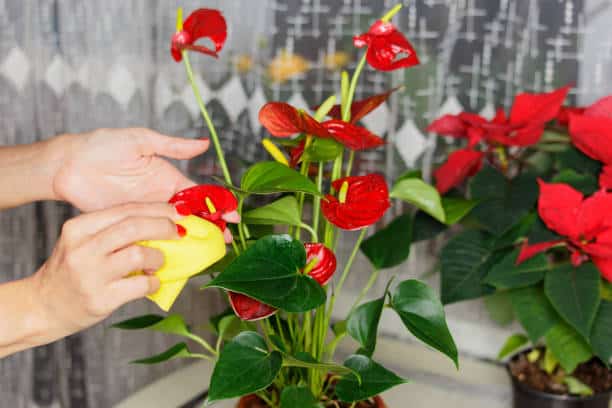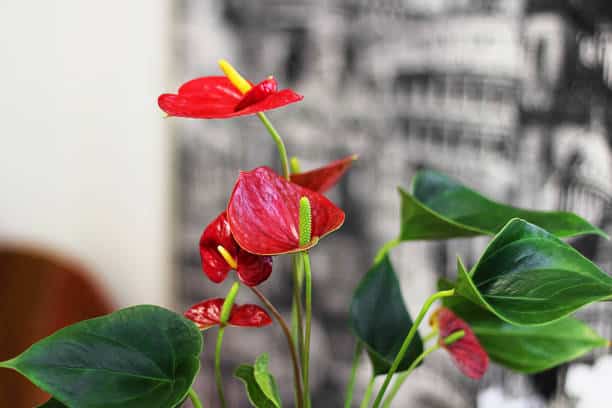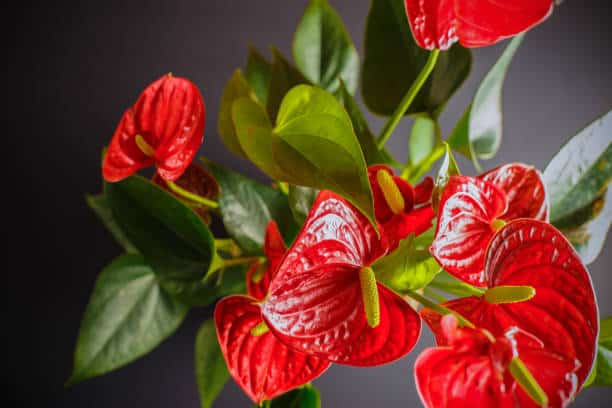Anthurium care is easy when there is a guide to help you. Follow the steps below and you will be on your way to growing beautiful Anthuriums.
While the flowers are spectacular, care of the plants themselves is not difficult. The plant itself has an interesting history; it comes from tropical Central and South America, but does well in tropical or subtropical regions of Asia.
They were known by several names including flamingo flowers and lady of the night …they were used as decorations for religious festivals. This is a perennial flowering houseplant that should last for many years with proper care.
What Is A Anthurium?

Anthurium flowers are exotic and stunning. The unusual beauty of Anthurium is magnificent to behold, and its impressive form will surely bring a vibrant touch to any room.
If you’re interested in growing Anthurium yourself, take a look at this excellent guide for proper care, watering, light requirements, temperature control, and more!
Anthuriums are easy-to-grow plants with large leaves that can develop into impressive blossoms as they mature.
While commonly grown indoors, the plant has become very popular with tropical gardeners since it can thrive outside under sunlight or artificial lighting if temperatures remain above 50 degrees F (10 C).
Although they produce beautiful flowers that last several days, many people grow them because of their dark green leaves, ranging from bright green to black. The combination of colorful leaves and exotic flowers is stunning.
Anthurium plants have heart-shaped leaves and long spikes that produce fragrant flowers. A few species are known for their monstrously huge blooms, and these plants make great additions to creative displays and centerpieces.
Anthuriums can be grown at home with proper care instructions; however, it is important to understand that the plant may take some time before it grows into a mature specimen.
Plants purchased online or through garden centers may have already been flowering for a year or two when they arrive on your doorstep.
Always ask about sizes before you purchase your Anthurium plant because adult specimens often grow too large for home-growing.
Anthurium Care & Maintenance
The Anthurium is a tropical plant that will not tolerate freezing temperatures.
If you want to grow your Anthurium outside in warmer months, ensure it is protected from extreme weather conditions and provided with ample sunlight.
When growing an indoor Anthurium plant, always keep in mind that the lighter the leaves receive while indoors, the larger and heavier they will become.
This may present a challenge if you plan on displaying your potted plants outdoors during warm summer evenings or springtime celebrations.
Your new Anthurium should be kept in an area between 65-85 degrees F (18-29 C) and fairly well lit; located within 8 feet of windows, or artificial lighting should suffice.
Some owners prefer to place their Anthurium on a sunny windowsill, while others use a grow light.
While Anthurium plants need plenty of sunshine, they will also thrive in artificial light or some shade outdoors.
However, the plants won’t be as vibrant in color and may experience stunted growth if not placed within an area that receives at least 4-5 hours of full sunlight each day.
Anthurium Care & Light Requirements:

Although they produce beautiful flowers that last several days, many people grow them because of their dark green leaves, ranging from bright green to black. The combination of colorful leaves and exotic flowers is stunning.
Anthurium plants have heart-shaped leaves and long spikes that produce fragrant flowers.
A few species are known for their monstrously huge blooms, and these plants make great additions to creative displays and centerpieces.
Anthuriums can be grown at home with proper care instructions; however, it is important to understand that the plant may take some time before it grows into a mature specimen.
Plants purchased online or through garden centers may have already been flowering for a year or two when they arrive on your doorstep.
Always ask about sizes before you purchase your Anthurium plant because adult specimens often grow too large for home-growing.
Anthurium Care & Water Requirements:
Anthurium plants require water that is changed frequently.
Since the Anthurium is prone to root rot, especially if placed in water that is too cold or not warm enough, always use room-temperature water.
It’s important to ensure your plant has been watered well before moving it into direct sunlight, as hot soil damages roots.
Avoid water that has accumulated on leaves or the soil’s surface, as it can cause rot and fungus.
When replacing water in your plant’s container, be sure to use a good quality potting mix; add one teaspoon of liquid houseplant fertilizer for each 1-gallon jug used.
It is never a good idea to fertilize your Anthurium with chemical fertilizers – especially if you are growing an indoor plant.
Some people prefer to grow their plants outdoors to prevent chemicals from leaching into the soil.
When watering your plants, make sure you don’t spray the leaves with water to avoid fungal infections and keep the soil moist without causing standing water around the base of your potted plant.
Avoid allowing the plant soil or its pot to become completely dry, as this will weaken and eventually kill your Anthurium.
Anthurium Care For Soil Requirements:
Anthurium plants are tropical by nature. Therefore they must have soil that is rich and loamy.
Avoid potting mixes containing sphagnum peat moss or charcoal (used to improve drainage).
These materials tend to dry out quickly and harbor a fungus that causes root rot, which will lead to the eventual demise of your plant.
If you choose to use perlite as a growing medium for your Anthurium, you should not allow water to accumulate in the container after watering; remember, this indicates it contains too much perlite.
You may need to add more organic material such as composted bark or coco fiber if this occurs.
Anthurium plants are also susceptible to root rot caused by over-watering.
This fungal disease is exacerbated by a potting medium that contains too much peat moss.
The best way to avoid a deadly fungus infection is to make sure your plant receives at least 4 hours of sunlight each day. The growing medium in its pot has been thoroughly wetted before placing it in direct sunlight, and the soil is kept evenly moist but not soggy.
As previously noted, try adding a small amount of liquid fertilizer and a good quality compost to enrich the soil, but be sure not to overdo it.
The best way to fertilize your Anthurium plant is by using a time-released granular or slow-release pellet fertilizer that has been diluted with water.
Not only will this method prevent excessive nutrients from building up in the soil, you won’t need to fertilize as often – also beneficial for those who believe more chemicals are better.
Temperature and Humidity Requirements:

The person caring for the Anthurium plant must remember that these tropical species require temperatures between 60 and 80 degrees Fahrenheit during the day, with no more than 10 degrees drop at night.
As previously stated, it is crucial to maintain a minimum winter temperature of 68 degrees Fahrenheit if you plan on growing an indoor plant to prevent damage due to cold weather.
Keep these plants outdoors in sheltered areas; they are not as susceptible to frostbite but need protection from strong winds.
Also, be sure your potted plants are moved into a spot that receives at least 4 hours of sunlight daily – direct exposure to natural light will help retain its rich green color throughout the year.
If your living space gets quite cold during the winter months, remember to move your Anthurium indoors before the temperature drops below 50 degrees.
Keep these tropical plants out of drafty areas. They should be situated in a warm room that doesn’t get too hot or too cold; their large leaves will provide plenty of protection from sudden temperature changes.
Your indoor Anthurium plant also requires 60-75% humidity during the day and about 50% at night.
Do everything you can to maintain this range by keeping your houseplants away from heat vents, open windows, doors, and other sources of dry air – which will cause leaves to wilt and drop off of stems.
To help increase the humidity level around your potted plants, place them on a tray filled with moist pebbles, or cover the tops of their pots with clear plastic wrap.
Ensure you remove any leaves that have dropped to the bottom of your Anthurium pot because the decomposing leaf material could lead to root rot if not cleaned up regularly – an unhealthy practice for these plants.
Anthurium Care For Fertilizing Requirements:
Anthurium plants are heavy feeders, so it’s important to fertilize them regularly – especially during their blooming season. A monthly diluted liquid houseplant fertilizer application will keep your Anthurium looking fresh and healthy all year round.
If you don’t want to use a synthetic fertilizer on your potted plant, consider using either a natural commercial product or an organic homemade mixture with other additives such as seaweed extract and earthworm castings – and call the local agricultural extension service office in your county for more information about where to obtain these materials.
You can also purchase products made from fish emulsion; remember that these products need to sit overnight before applying directly onto the soil surrounding the root system of your indoor Anthurium plants.
At the beginning of spring, when Anthuriums are put out in the garden, they should be fertilized with a granular fertilizer that is high in phosphorous and potassium (such as 10-10-10 or 8-8-8). They also need a top dressing of lawn lime to help build up the soil’s pH level.
Remember, you must wait until shoots appear before fertilizing – don’t apply fertilizer before planting!
Anthurium Care For Potting and repotting Requirements:

If you have an Anthurium plant in a container that is over two years old, you should replace the potting soil. Replace the top 2-3 inches of soil every four to six months and add fresh gravel on top as needed to help keep moisture levels consistent throughout the year.
Your potted plant will also need repotting about every 2 years if it continues to grow and produce new stems; during this time, be sure to use a mixture containing sphagnum moss or peat (it must be sterile). Also,, consider using a container with drainage holes for your indoor Anthurium – this will make watering much easier.
Anthurium plants do not like being root bound, so try to repot only when the plant is actively growing.
Repot plants in early spring before the onset of hot weather if you wish to encourage additional flower growth during the summer months. These tropical plants may also be repotted at other times of the year, but repotting should not occur outdoors!
Always try to repot your Anthurium immediately after flowering – this will help ensure that it has time to adjust its root system before new shoots are produced for next season’s blooms. Clean up any leaves or fallen flowers before placing your potted plant in a fresh pot; however, do not be concerned about removing all traces of old soil (once roots have been established, they can tolerate some transplanting).
Once you have removed your Anthurium from its old pot and it has been replanted in a new container filled with fresh potting soil, try not to move the potted plant for about one month. This will give the root system time to re-establish itself.
Propagation Info:
Anthurium is propagated by cutting the rhizomes into sections. Each section will produce a new Anthurium plant, which should then be repotted and cared for as you would any other potted Anthurium.
If you don’t want to keep all of your new plants, it’s important to remove the excess rooted sections from your original potted plant so that you aren’t over-crowding its root system.
The best time to do this is in spring when propagation can occur easily because of warmer weather and plentiful light.
Be sure to cut back on fertilizing during this time – even though fertilizers promote growth they may actually inhibit good rooting if used immediately after propagation takes place.
Anthurium Care For Pests And Diseases
Because Anthurium leaves are highly vulnerable to moisture and insects, you should make sure your plant never gets too wet or sits in soil that is too damp.
Proper watering methods can help keep annoying pests away from your potted plants. Pesticides should only be used when the infestation becomes unbearable.
When applying products to stop an infestation, be sure the product is labeled as safe for houseplants and follow the directions carefully.
Always check with a professional if you a virus or fungus has infected your Anthuriumr fungus.











